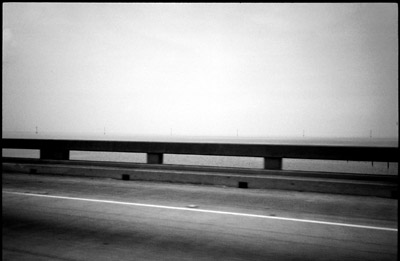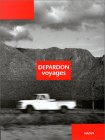



Voyages Hazan 1998, ISBN 2850256420
Le Désert Américain Cahiers du Cinema 1983, ISBN 2866420071
Errance Seuil 2000, ISBN 2020386879
There are online portfolios of Raymond Depardon's pictures on the Alpa and Magnum websites.
Raymond Depardon doesn't seem to be as well known outside France as he should be - I had never heard of him until I first came across some of his pictures in Magnum Landscape. Voyages is listed on Amazon's US site (here, but only on back order) and I bought it at a bookshop in London, but I had two order the other two books I have of his from Amazon France. The pictures I first saw in Magnum Landscape amazed me, and I've been equally impressed as I've seen more of his work. He is my number one photographic hero - the photographer whose pictures most often make me think “Wow, that is amazing. How did he see that? I'd love to be able to take pictures like that”. Which is perhaps a little worrying.
He has the most magical eye for line and composition, and can make a fascinating image out of something nobody else would even look twice at, let alone try to photograph. They are pure line and composition, striking graphics made out of apparently nothing - edges of a desert road converging towards a distant horizon; painted lines on a sun-scorched Arizona parking lot with one lonely car on the horizon. But they're bleak pictures - stark, empty landscapes that aren't “beautiful” in any conventional sense. People when they appear are isolated, alienated figures in a landscape - elements in the composition, not the centre of sympathy and interest the way they are in, for example so many of Henri Cartier Bresson's pictures. So what does this say about Monsieur Depardon - and about me, if I find his pictures so compelling?
I find Depardon reveals more of his personality in what he writes in his books than most photographers do, too - and (if my French is up to reading emotional nuances correctly) he confirms the impression his pictures give of being quite a lonely and melancholy man.
I could try saying in my defence as a Depardon fan that it's not the bleakness, alienation and melancholy per se that appeal to me, it's the clean, astract beauty of his sense of line and composition. Superficially it might be tempting to class him together with Cartier Bresson under a “famous and brilliant Leica-toting French photojournalists” heading, but the feel of their work is actually completely different. Cartier Bresson's pictures are hit and miss for me - some I love, others I just can't see what's supposed to be interesting or great about them. And the ones I love are still a complete mystery - I can't begin to grasp how they are done or why they work. Whereas with Depardon I feel as if I could almost, perhaps, one day, understand how the photographs hang together; how he does this alchemical thing of putting everything in just the right place to pull a striking image out of nothing.From a not-quite-so-interesting technical point of view, he is also the photographer whose pictures most make me think there might actually be some real basis for the great Leica cult. I found myself looking through the pictures in Voyages thinking “There really is something special about the sharpness and sense of depth in these. He's a famous Magnum photographer. Am I actually seeing the fabled Leica magic?”. And sure enough, there on page 157 is a car mirror shot clearly showing Raymond behind the viewfinder of an M3. And in the technical note at the back of the book: “The great majority of the photographs in this book were taken with a Leica M … most often with a single body and a 50 mm lens.” In the hands of a master, less is more.

|
Me trying to be just like Raymond … Lake Pontchartrain in Louisiana from a moving car, 1999. Taken with a small, simple, basic camera with a superlative lens - not a Leica but a Yashica T4 |
photos and text ©1999-2001 Alan Little